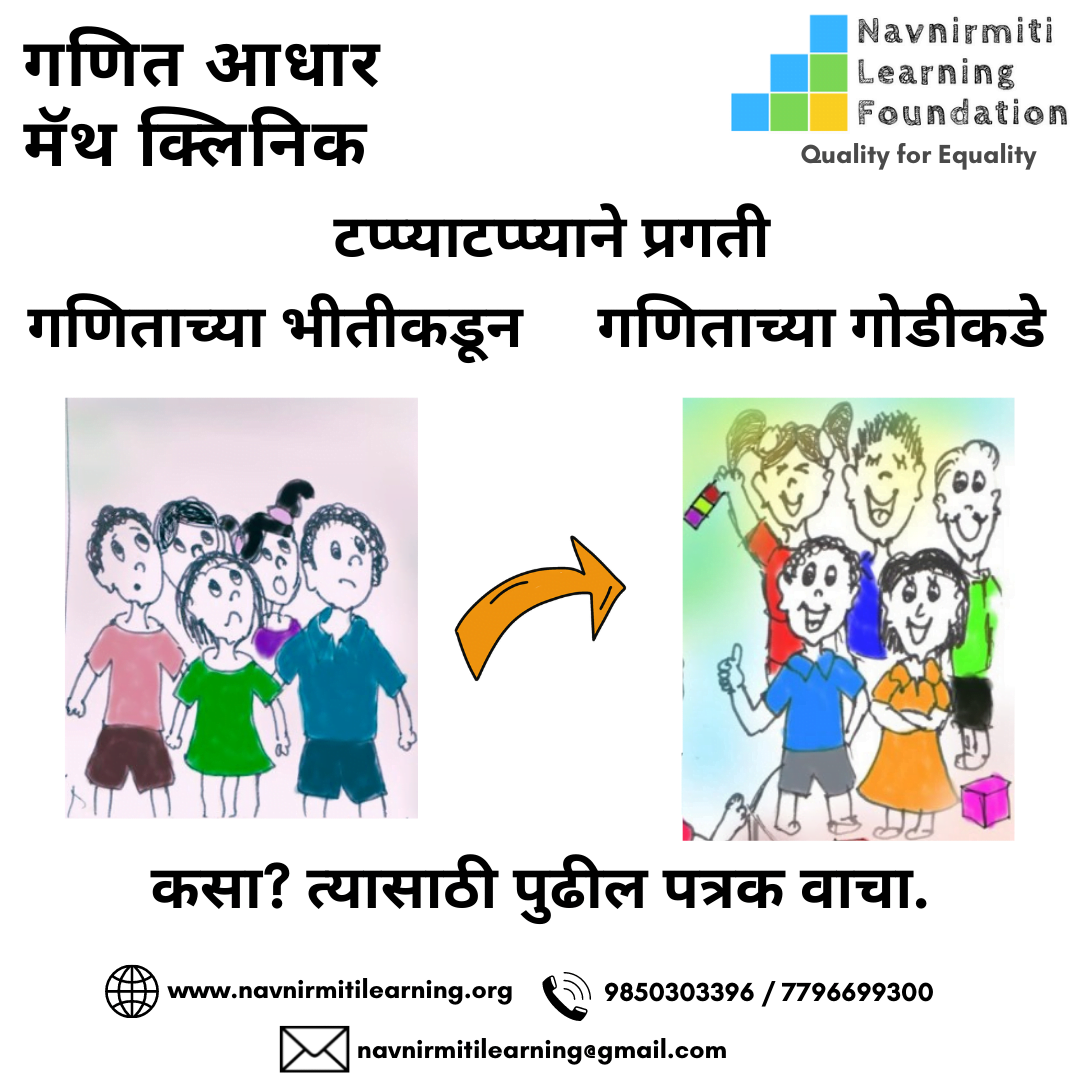Math Comfort Test / गणित स्वास्थ्य चाचपणी
Dear Parent / teacher,
प्रिय पालक / शिक्षक
Why conduct this Math comfort test with your children?
तुमच्या मुलांबरोबर गणित स्वास्थ्य चाचपणी का करायची?
By class 10, most children develop a dislike for math, even math phobia. But the origins of this fear often lies in the math experience of the child in primary school. Today, due to the pandemic insecurities, long period out of school, the unsatisfactory experience of online learning, children are facing more obstacles to math learning.
दहावीतल्या अनेक मुलांना गणिताची नावड, किंबहुना भीती निर्माण होते. परंतु या भीतीची मुळं प्रार्थमिक शाळेतल्या गणिताच्या अनुभवातच असतात. महामारीच्या भीतीच्या वातावरणामुळे, मोठ्या सुट्टीमुळे, ऑनलाईन शिक्षणातल्या असमाधानकारक अनुभवामुळे मुलांच्या गणित शिक्षणात आज आणखीनच अडथळे निर्माण झाले आहेत.
If these problems are addressed in good time, we can ensure that these obstacles do not develop into a lifetime math phobia. To begin with you can yourself conduct this simple math health assessment with your children. This is not a comprehensive examination. It will not measure math competency level. It is like feeling for temperature or using a weigh machine. It is just a test of basic math comfort. You can do the assessment yourself at home. In this assessment children should perform the activity themselves without any prompting.
वेळच्या वेळी ह्याकडे लक्ष दिले तर पुढे जाऊन मुलांना गणिताचा फोबिया निर्माण होणार नाही. यासाठी मुलांच्या गणिताच्या स्वास्थ्याची चाचपणी तुम्ही घरच्या घरी करू शकाल. ही सर्वंकष, परिपूर्ण चाचणी नाही. केवळ चाचपणी आहे. मुलांची गणिताची पातळी यातून कळणे अपेक्षित नाही. आपण कपाळावर हात लावून ताप तपासतो, वजन पाहतो, ह्यासारखं हे आहे. गणिताशी सहजता आहे की नाही ते यातून कळेल. या चाचणीत मुलांनी कृती करायची आहे, स्वतः विचार करायचा आहे. त्यांना सूचना करायच्या नाहीत.
How to conduct this test ?
ही चाचणी कशी करायची ?
Take it easy ! This is not a board exam. It is to be done in a playful and relaxed way, without stress for either you or your child.
Let’s say your child is going into class 5 when school reopens. Commence with the class 5 test. If the child is finding that difficult, go back and ask questions from the class 4 test., and so on. Don’t worry if the child has problems with the earlier class concepts. The purpose of this test is to find the level at which the child is comfortable. Math discomfort will be addressed beginning from that level.
सहज खेळता खेळता मुलांसोबत पुढील गोष्टी तपासून पाहा. प्रश्न विचारलात, की थांबा. अपेक्षित उत्तर काय आहे ते विसरून जा, सूचना करू नका, मदत करू नका. मुलाला/मुलीला
विचार करायला वेळ द्या. त्याच्या / तिच्या पद्धतीला विचार करू दया. मूल विचार कसा करत आहे याकडे जास्त लक्ष द्या. मूल गणिताला घाबरत आहे का, की गणिताशी तिची/त्याची मैत्री आहे याचा अंदाज घ्या. पूर्ण चाचणी एकाच वेळी करायची गरज नाही. मुलांच्या कलाने करा. दोनचार दिवसात केलं तरी चालेल. ज्या इयत्तेत तुमचे मूल जाणार आहे त्या इयत्तेचे प्रश्न विचारा. त्यात अडचण आहे असे दिसल्यास आधीच्या इयत्तेचे प्रश्न विचारा. याप्रमाणे आवश्यक तितके मागे जा.
Our team of resource persons is always ready to help you.
आम्ही तुमची मदत करण्यासाठी नेहमीच हजर असू.
सातत्यपूर्ण सर्वंकष मूल्यमापन – सक्रिय जनगणित – गणिताच्या समजेचे सातत्यपूर्ण मूल्यमापन
वर्षअखेरचे नमुना नैदानिक मूल्यमापन – सतत प्रगतीचा कार्यक्रम करताना वापरायचे मूल्यमापन
End Year Random Sample Assessment for Basic concepts in ENGLISH AND BENGALI : (Practical Mental Math and Written)
| Class 1 to 5 End year assessment in English | Class 6 to 8 year end assessment in English | Class 1-5 end year assessment in Bengali | Class 6-8 end year assessment in Bengali |
Assessments For Community Math Lab :
Baseline and Endline Assessment – Class 1
Baseline and Endline Assessment – Class 2
Baseline and Endline Assessment – Class 3
Baseline and Endline Assessment – Class 4
Join Over 10,000 Students, Teachers & Parents Enjoying Maths
Become Part of NLF family.








Get Social